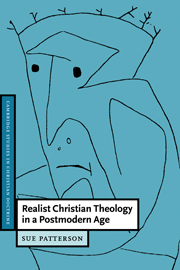Book contents
- Frontmatter
- Contents
- Acknowledgements
- Introduction
- 1 The task of theological realism
- 2 The dilemma of postliberal theology
- 3 Interpreting the truth
- 4 The anatomy of language-riddenness
- 5 The nature of theistic realism
- 6 Becoming persons
- 7 Becoming the Church
- Conclusion
- Select bibliography
- Index of names
- Index of subjects
4 - The anatomy of language-riddenness
Published online by Cambridge University Press: 02 December 2009
- Frontmatter
- Contents
- Acknowledgements
- Introduction
- 1 The task of theological realism
- 2 The dilemma of postliberal theology
- 3 Interpreting the truth
- 4 The anatomy of language-riddenness
- 5 The nature of theistic realism
- 6 Becoming persons
- 7 Becoming the Church
- Conclusion
- Select bibliography
- Index of names
- Index of subjects
Summary
It has been noted that while theological realism and liberal revisionism are both able to account for new truths, they differ on whether this new truth is something we discover as our concepts are brought into line with it and are able to grasp it, or whether this is at least in part something that human concepts participate in and have a role in creating. Although these positions may seem implacably opposed in coming from quite different metaphysical stances, this opposition might be construed as simply reflecting these different premises rather than ruling out one or the other as false. In other words, the clash of premises may itself be seen as indicating the need for a more comprehensive integrative model that is able to accommodate both realist and postmodern elements. What has emerged so far in the search for such a higher organizing model is a sketch of a theistic realism whose logic has been identified as both incarnational and trinitarian and its dynamic accordingly as co-inherent, or perichoretic.
It has been suggested that it will be necessary to supplement the horizontal ‘how’ dimension with some input from another paradigm before beginning to work out the ‘vertical’ aspects of such a model. If this imported paradigm is able to supply more infrastructure, it will be possible to describe more adequately the process as well as the content of the theological endeavour in a way that is still consistent with its structure. The proposal to be tested here is that a Wittgensteinian paradigm will serve this purpose, but a Wittgensteinian paradigm that goes beyond the postliberal use of Wittgenstein and is more comprehensive than the postmodern weak thesis although essentially consistent with it.
- Type
- Chapter
- Information
- Realist Christian Theology in a Postmodern Age , pp. 73 - 93Publisher: Cambridge University PressPrint publication year: 1999

